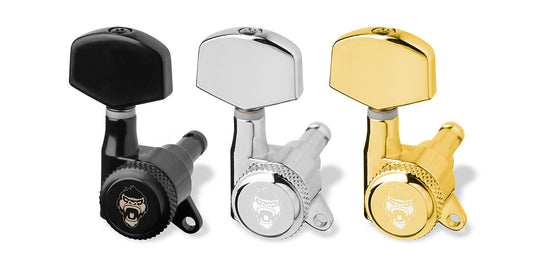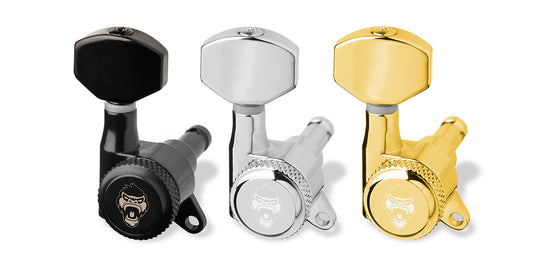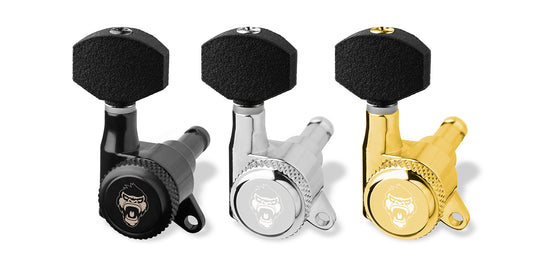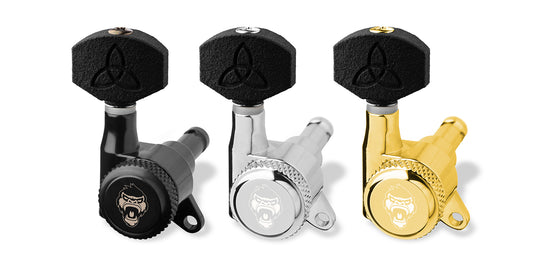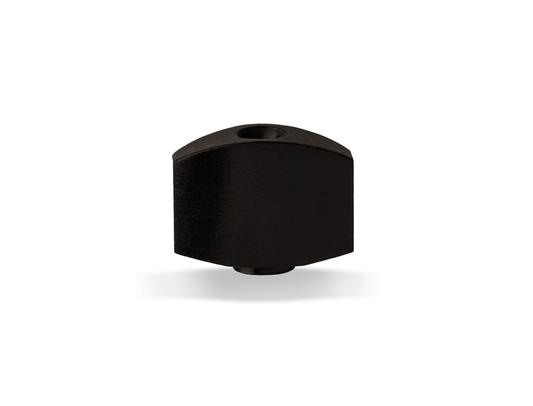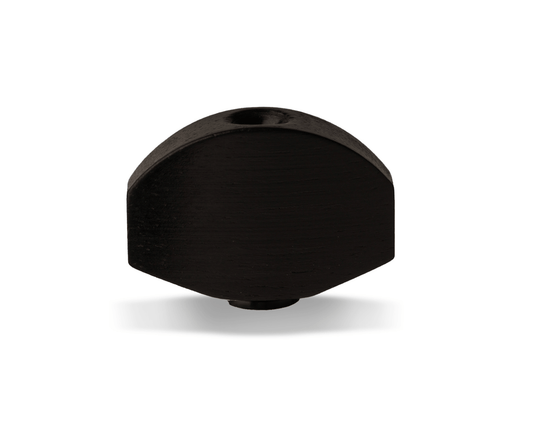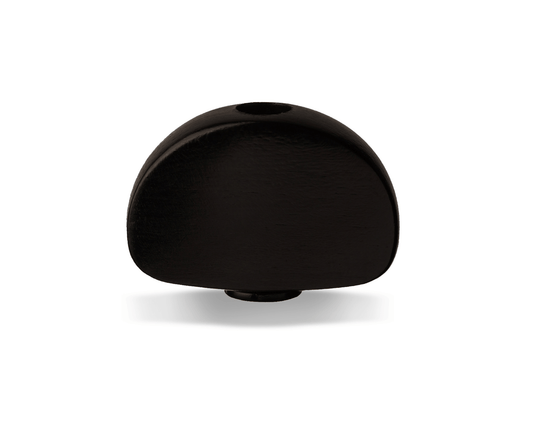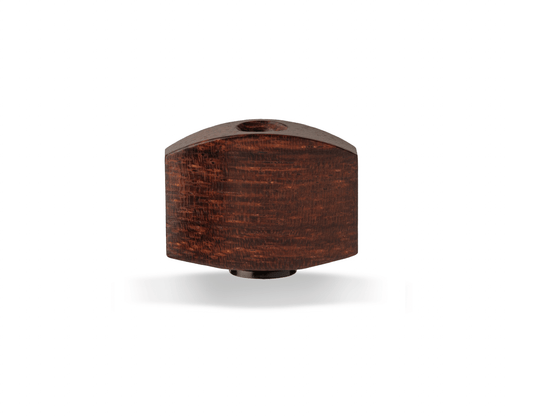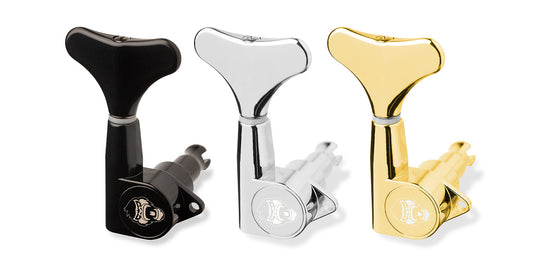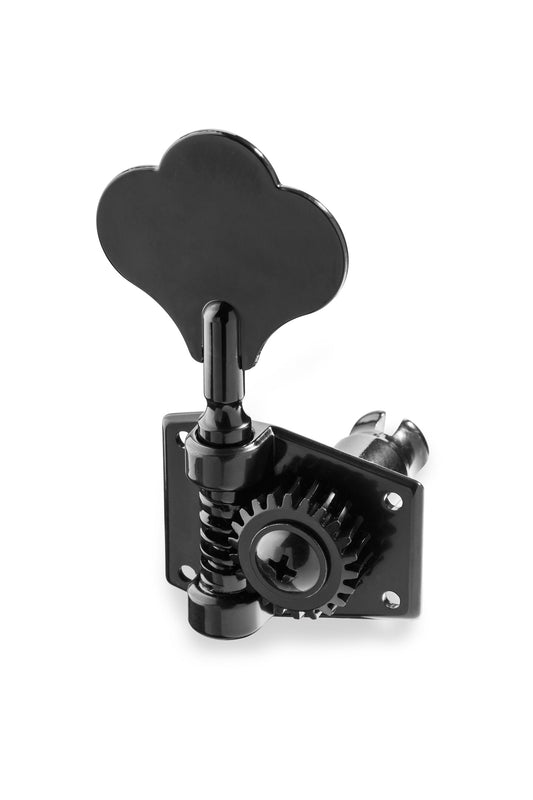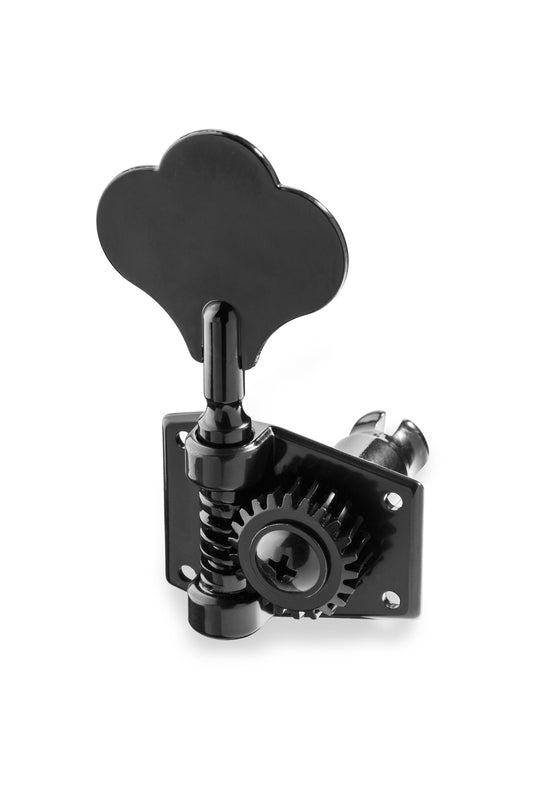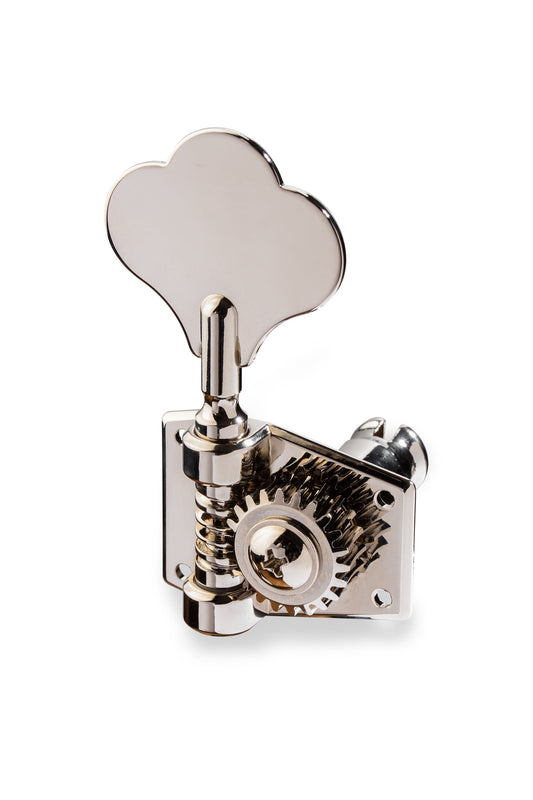Guitar and bass machine heads in general
Collapsible content
Can I buy guitar machine heads individually?
Yes, you can buy all of the guitar and bass tuners we offer individually. Just have a look in our shop .
We also offer various custom options for guitars and bass mechanics.
What is left, what is right guitar mechanics?
A distinction is made between left and right guitar mechanics. A left-hand machine has its neck on the left, a right-hand machine has its neck on the right.
What does bass side and treble side mean in guitar machine heads?
It means whether it is a left (bass side) or right (treble side) guitar mechanism.
You can find out how to distinguish between left and right guitar mechanics here.
What does gear ratio mean in guitar machine heads?
A worm gear works in every guitar mechanism. This worm gear consists of a worm shaft and a gear wheel, which is also called a worm wheel.
The button of the guitar mechanics is on the worm shaft. The worm wheel sits on the adjusting axle (post) in which the guitar string is attached.
If you now turn the button of the guitar mechanics, the worm shaft also turns and drives the worm wheel with the adjusting axis (post). The adjusting axis (post) with the guitar string rotates and the guitar string is tuned.
Of course, worm gears also have different translations. Common translations are 12:1, 15:1, 16:1, 18:1, 19:1 or 20:1.
A gear ratio of 18:1 to one means that you have to turn the button of the machine heads exactly 18 times so that the adjusting axis (post) with the attached guitar string also turns around itself once.
So a high gear ratio means you have to turn more often to tune the guitar or bass one note up or down. So the guitar can be fine tuned.
A low gear ratio means you don't have to turn as often to tune a note down or up.
For our Monkey Locks - Locking Tuner we have chosen a gear ratio of 18:1 because we believe this is the perfect gear ratio. The guitar can be tuned very finely and precisely, but you don't have to turn it often unnecessarily to achieve a result.
Our bass machine heads have a gear ratio of 20:1.
Learn more about our Monkey Locks - locking tuners / clamping mechanisms.
What does staggered posts/mechanics mean?
With staggered machine heads, the rear adjusting axles (posts), in which the guitar strings are attached, are shorter than the front ones. This increases the string pressure on the saddle in the rear guitar machine heads.
Staggered machine heads only make sense for guitars without headstock angles that don't have string retainers. Since this is very rare, we currently do not offer any staggered variants for our Monkey Locks - Locking Tuners.
My guitar is top heavy, what can I do about it?
Inexpensive guitar tuners in particular often weigh much more than quality tuners. Therefore, the weight can be significantly reduced by exchanging the guitar mechanics. If you don't want to change your tuners, you can reduce the weight by over 20% simply by swapping the metal tuning buttons for wooden tuning buttons, which can be very beneficial for top-heavy guitars. A wider belt can also help.
How do I correctly install guitar and bass machine heads on my guitar/bass?
Do you also repair guitar and bass mechanics?
Unfortunately we do not offer a repair service.
How do I clean guitar and bass mechanics correctly?
tbd
Swap guitar tuners? Why should I do that?
Why should I swap guitar or bass machine heads?
There are many reasons for that. Defective mechanisms must of course be replaced, that is completely clear. But inferior or outdated guitar and bass mechanics should also be exchanged.
Because high-quality guitars and bass mechanics make it easier to tune your instrument and of course keep the tuning much more precise. Locking tuners / clamping mechanisms in particular are ideal for keeping the tuning precise and at the same time speeding up the string change.
Monkey Locks - locking tuners / clamping mechanisms
Collapsible content
Do you also sell spacers individually?
No, unfortunately no. However, we sell the rings in matching sets for the number of strings on your guitar. Just drop by the shop .
Do you offer locking tuners for left-handed guitars?
Of course! We offer almost 900 different set combinations. We always want to know whether you play a right-handed or left-handed guitar in order to be able to put together the mechanics with the larger string holes correctly for your set.
Do you also offer locking tuners / clamping mechanisms for guitars with reverse headstock / headstocks?
Of course! We offer almost 900 different set combinations. We always want to know whether you play a right-handed or left-handed guitar in order to be able to put together the mechanics with the larger string holes correctly for your set.
What are locking tuners / clamping mechanisms?
Locking tuners, also known as clamping mechanisms, are guitar mechanisms that lock the string with a locking mechanism. Thus, the string is tight and can no longer be out of tune. It is also possible to tune the guitar faster because it no longer needs windings.
Our Monkey Locks work with a clamping wheel which is slightly tightened by hand on the back of the guitar mechanics. As a result, a metal pin inside the pin presses against the guitar string and anchors it firmly to the mechanics.
Here you will find all the functions that make our Monkey Locks - Locking Tuners so special.
What are the advantages and disadvantages of locking tuners / clamping mechanisms?
The advantages of locking tuners / clamping mechanisms clearly outweigh the few disadvantages.
advantages
+ Tuning stability
Locking tuners ensure a stable guitar (of course only if the saddle and the bridge are of good quality)
+ faster string changes
Since no additional windings are necessary, changing strings is done very quickly
Disadvantages
- Locking tuners are often more expensive than non-locking tuners. But you get the locking function
- Locking tuners are often heavier than non-locking tuners. However, this mass can also mean an increase in sustain.
However, our locking tuners are among the lightest on the market. With our wooden buttons in particular, the weight can be reduced even further
Do locking tuners / clamping mechanisms only make sense with tremolo / vibrato guitars?
No! Locking tuners also make sense for guitars without a tremolo system. Because even on guitars with a fixed bridge, the string windings on the mechanics loosen when playing and bending. This happens even when strings are wound very well. Therefore, locking tuners make sense on all types of guitars when you want tuning stability and fast string changing.
Will my guitar never go out of tune with locking tuners?
Our Monkey Locks - Locking Tuners are among the best mechanics on the market. They work extremely precisely and the locking mechanism also secures the strings securely.
However, other parts of a guitar are also responsible for tuning stability, such as the saddle and the bridge.
So if the saddle and the bridge of the guitar are also of outstanding quality, your guitar will be completely in tune with the Monkey Locks - Locking Tuner.
Are Monkey Locks - locking tuners / clamping mechanisms also suitable for acoustic guitars and lap steel / pedal steel guitars?
Our Monkey Locks - Locking Tuners are suitable for electric guitars as well as for acoustic guitars and lap steel or pedal steel guitars.
It is only important to look at the specifications to ensure that the locking tuners fit your instrument.
Pay particular attention to the 135 degree screw lug and the height of the pin, which is suitable for headstocks with a thickness between 12.7mm and 16mm.
Find out more about the technical data of the Monkey Locks - Locking Tuners here
Do locking tuners change the sound of a guitar?
The slightly higher weight of the locking tuners / clamping mechanisms adds a little more mass to the guitar's headstock. This allows the guitar to have more sustain and a slightly fatter tone. The effect is similar to a fat finger.
What is the size of the hole in the headstock of my guitar?
Most modern guitars have a hole size of 10 millimeters. Vintage instruments often have a hole diameter of 8.5mm.
Our Monkey Locks - locking tuners / clamping mechanisms fit headstocks with hole diameters of 9.9mm to 10mm.
If you have 8.5mm holes, you can simply drill them out with a countersink (10mm). If you are unsure, any guitar builder will do this for you.
It is best to take a look at our technical drawing here before you buy our mechanics.
How do I know if the locking tuners / clamping mechanisms also fit my guitar?
Basically you have to consider 3 things:
1. Angle of the screw lug
Our Monkey Locks locking tuners / clamping mechanisms have a 135 degree screw lug. This fits a lot of guitars, but not all. Of course you can also drill holes to install our Monkey Locks if your guitar doesn't have holes for 135 degrees.
2. Headstock hole diameter
Most modern guitars have hole diameters of 10mm. Vintage instruments often have a hole diameter of 8.5mm.
Our Monkey Locks - locking tuners / clamping mechanisms fit headstocks with hole diameters of 9.9mm to 10mm.
If you have 8.5mm holes, you can simply drill them out with a countersink (10mm). If you are unsure, any guitar builder will do this for you.
3. Headstock thickness
Our Monkey Locks fit headstocks with a thickness between 12.6mm and 16mm. This is the normal standard and given with almost all guitars.
Basically, it is important that you look at our technical drawing before you buy to find out the exact dimensions.
How do I install/swap locking tuners/locking machine heads on my guitar?
Installing Locking Tuners - I need to drill new holes, what size hole do I need?
Our screws have a diameter of 2.3mm.
For hardwood headstocks (such as Mahogany, Maple, Rosewood, Koa, Korina) drill a 2.0mm diameter hole.
For softwood headstocks (rather rare), drill a 1.6mm diameter hole.
Do you also offer staggered mechanics?
Staggered machine heads only make sense for guitars without headstock angles that don't have string retainers. Since this is very rare, we currently do not offer any staggered variants for our Monkey Locks - Locking Tuners.
Do you offer spare parts for your Monkey Locks - Locking Tuners / clamping mechanisms?
Currently we only offer spacer rings for guitars and basses. You can find these in our shop . We will soon also offer other spare parts.
Do I have to oil or grease Monkey Locks - Locking Tuners clamping mechanisms?
No, our mechanics are closed and you don't have to grease them (mechanics are generally greased with Teflon grease, not oiled).
Open mechanics, on the other hand, can take a little grease after a few years after the mechanics have been thoroughly cleaned.
Learn more about the benefits of our mechanics here .
How do I use locking tuners correctly? How do I wind strings correctly with Locking Tuners?
It is extremely important that locking tuners are not used like normal guitar tuners. With normal guitar tuners, the strings are wrapped around the adjusting axis/post. This can cause the strings to slip slightly and thus put the guitar out of tune.
This is avoided with locking tuners. But here it is extremely important that the strings are not wrapped around the adjusting axis/post.
Open the clamping screw of your Monkey Locks - Locking Tuners and insert the string through the hole and pull the string tight. Clamp the strings by locking the clamping screw again. Cut off the excess string. Now tune the guitar.
Guitar Monkey wood buttons
Collapsible content
How do I know if the wooden buttons / knobs also fit on my mechanics / guitar?
There are different mechanical shaft sizes on the market that are used by the manufacturers. Therefore, not every button fits every mechanism.
We therefore offer our wooden buttons with three different inserts in order to be able to offer them for almost all mechanics.
Here you can find out more about the dimensions and the right inserts for your mechanics.
How do I install/swap the wood buttons/knobs on my guitar machine heads?
How can I set the smoothness of my guitar mechanics buttons / knobs?
The smoothness of the mechanisms can be easily adjusted using the button screw.
Here you can find out in our instructions how to set the functionality of the mechanics.
Our Monkey Locks - Locking Tuners
-
Single - Monkey Lock - Locking Tuner - Guitar Clamp Mechanism - Big German Metal Button
Normal price From €12,50Normal pricebasic price / pro -
Single - Monkey Lock - Locking Tuner - Guitar Clamp Mechanism - Small German Metal Button
Normal price From €12,50Normal pricebasic price / pro -
Single - Monkey Lock - Locking Tuner - Guitar Clamp Mechanism - Megalight Monkey Grip Button - Small German
Normal price From €14,20Normal pricebasic price / pro -
Single - Monkey Lock - Locking Tuner - Guitar Clamp Mechanism - Celtic Megalight Monkey Grip Button - Small German
Normal price From €14,20Normal pricebasic price / pro
Matching our mechanics wooden buttons
-
Small German Ebony Guitar Mechanics Grand Piano / Tuner Buttons / Knobs
Normal price From €29,90Normal pricebasic price / pro -
Big German Ebony Guitar Mechanics Tuner Buttons / Wings / Knobs
Normal price From €29,90Normal pricebasic price / pro -
Big Vintage Kidney Bean Ebony Guitar Mechanics Tuner Buttons / Wings / Knobs
Normal price From €29,90Normal pricebasic price / pro -
Small German Tamarind Wood Guitar Mechanics Grand Piano / Tuner Buttons / Buttons
Normal price From €29,90Normal pricebasic price / pro
Our bass mechanics
-
Single Bass Mechanics - Slinky Metal Button
Normal price From €8,90Normal pricebasic price / pro -
Single (1 L) Silverback Vintage Bass Tuner Prejazz in Black - Clover Leaf Buttons
Normal price €12,50Normal pricebasic price / pro -
Single (1 R) Silverback Vintage Bass Tuner Prejazz in Black - Clover Leaf Buttons
Normal price €12,50Normal pricebasic price / pro -
Single (1 L) - Silverback Vintage Bass Mechanics Prejazz in Nickel - Clover Leaf Buttons
Normal price €12,50Normal pricebasic price / pro

